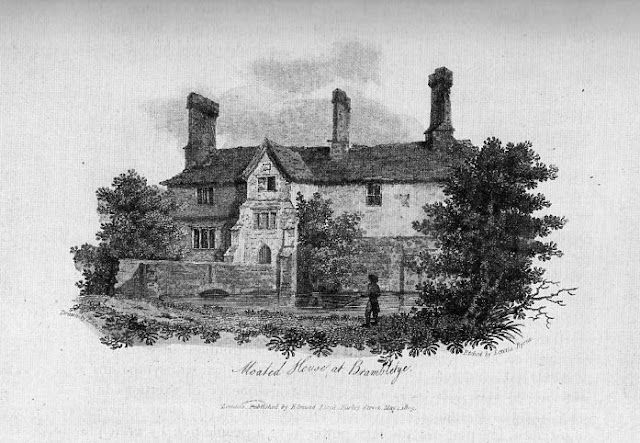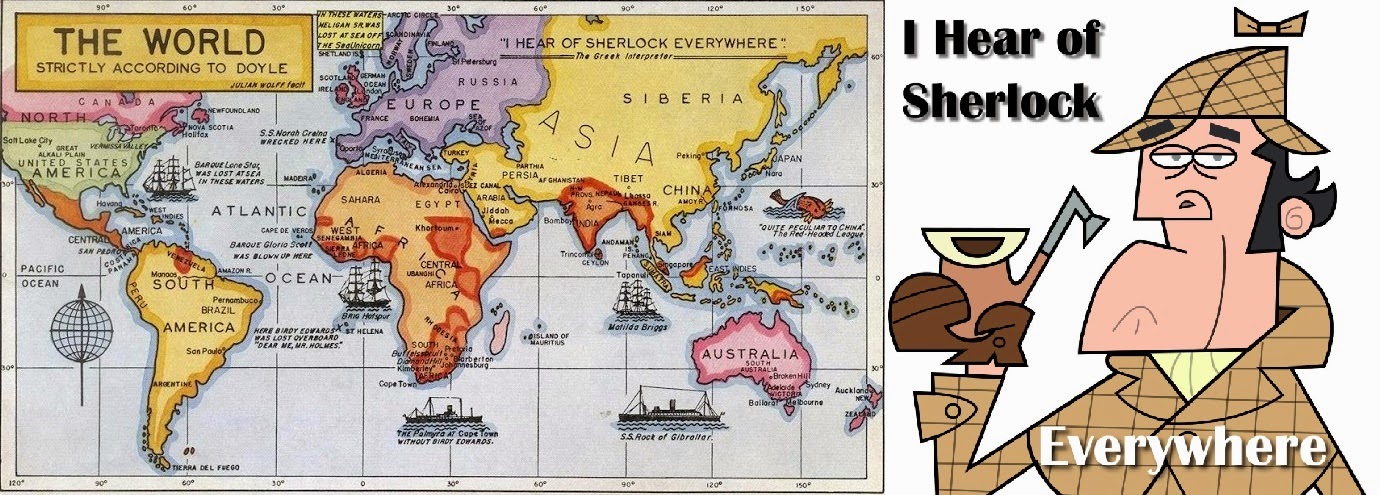"the ancient Manor House of Birlstone" [VALL]
If you've ever visited Royal Tunbridge Wells in Kent, it's likely that you've heard of Groombridge Place. It's an estate that dates from 1230, with the current manor house having been built in 1662.
One of the most notable features of the house is that it's moated. If that sounds familiar, then you may recall a moated house that played a part in one of the original 60 Sherlock Holmes stories: the moated house of Birlstone in The Valley of Fear.
[Note: this should not be confused with Hurlstone, in "The Musgrave Ritual." We recognize that this may occur occasionally because the names of the manor houses rhyme, and because the filming location for the Granada version of "The Musgrave Ritual" with Jeremy Brett was at Baddesley Clinton, another 500 year-old moated house.]
However, as with many locations, homes and names used in the Canon, there has been historic speculation about exactly which stately home inspired Birlstone in the 1914 novel. And as with many things in the Sherlockian world, it has been debated as well. With this entry, we'd like to bring you into a battle of titans and show how the definitive inspiration was debunked with some fairly incontrovertible proof.
"A Case of Identity"
Aside from the fascinating history of Groombridge Place, the property should be of interest to Sherlockians because of its associations with the Manor House of Birlstone in The Valley of Fear. But first a little history in the identification.H.W. Bell, BSI ("The Valley of Fear") was one of the early and great Sherlockian scholars and Baker Street Irregulars. Bell was a Bostonian (being an inveterate member of The Speckled Band of Boston) who carried on correspondence with a number of other Sherlockians, including Dorothy Sayers and Edgar Smith. Smith was impressed with Bell's Sherlock Holmes and Dr. Watson: The Chronology of Their Adventures (1932) and he included Bell's "Three Identifications" in Profile by Gaslight in 1944. It was in this monograph that Bell determined that Birlstone Manor was based on The Moated House at Brambletye.
In 1945, the year after the BSI began issuing investitures, Bell received his — "The Valley of Fear" — specifically to recognize his scholarship in this area (and it should be noted that the four novels — STUD, SIGN, HOUN and VALL — were considered uber-investitures and were given to some of the earliest and most significant Sherlockians of the day: Vincent Starrett, Christopher Morley, Edgar Smith and Bell, respectively).
 |
| The Moated House at Brambletye |
However, in Montgomery's Christmas Annual 1955
 |
| "With all kind remembrance from Arthur Conan Doyle who hopes you have pleasant memories of Groombridge House which is the old house herein described. June 22/21." |
But what of the "old house" itself? Here we have the description of Birlstone Manor from The Valley of Fear:
About half a mile from the town, standing in an old park famous for its huge beech trees, is the ancient Manor House of Birlstone. Part of this venerable building dates back to the time of the first Crusade, when Hugo de Capus built a fortalice in the centre of the estate, which had been granted to him by the Red King. This was destroyed by fire in 1543, and some of its smoke-blackened corner-stones were used when, in Jacobean times, a brick country house rose upon the ruins of the feudal castle. The Manor House, with its many gables and its small, diamond-paned windows, was still much as the builder had left it in the early seventeenth century. Of the double moats which had guarded its more warlike predecessor the outer had been allowed to dry up, and served the humble function of a kitchen garden. The inner one was still there, and lay, forty feet in breadth, though now only a few feet in depth, round the whole house. A small stream fed it and continued beyond it, so that the sheet of water, though turbid, was never ditch-like or unhealthy. The ground floor windows were within a foot of the surface of the water. The only approach to the house was over a drawbridge, the chains and windlass of which had long been rusted and broken. The latest tenants of the Manor House had, however, with characteristic energy, set this right, and the drawbridge was not only capable of being raised, but actually was raised every evening and lowered every morning. By thus renewing the custom of the old feudal days the Manor House was converted into an island during the night - a fact which had a very direct bearing upon the mystery which was soon to engage the attention of all England."
 |
| Map of Groombridge Place, Plate IX from Montgomery's Christmas Annual 1955: A Case of Identity |
So let's take a look at some of the grounds and the house that inspired Conan Doyle to create Birlstone Manor. All images are plates from Montgomery's Christmas Annual 1955: A Case of Identity.
 |
| Plate XII: "The long, low, Jacobean house of dingy, liver-coloured brick lay before us." |
 |
| Plate XIII: "The long sweep of the dull-coloured, water-lapped front." |
 |
| Plate XIV: "The Manor House, with its many gables and its small, diamond-paned windows." |
 |
| Plate XV: "The only approach to the house was over a drawbridge." |
 |
| Plate XVI: "Those strange peaked roofs and quaint overhung gables were a fitting covering to grim and terrible intrigue." |
 |
| Plate XVII: "Forty feet in breadth, though now only a few feet in depth." |
 |
| Plate XVIII: "The beautiful broad moat, as still and luminous as quicksilver." |
Photo credit: Wikimedia Commons ("Groombridge02" by Hans Bernhard (Schnobby)).
--



0 comments:
Post a Comment